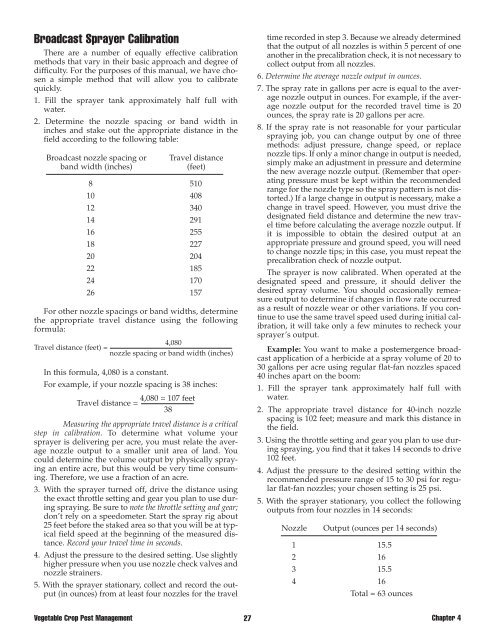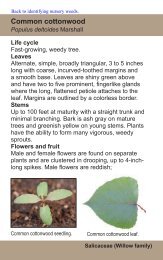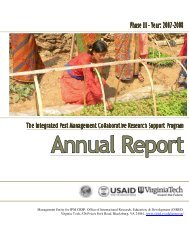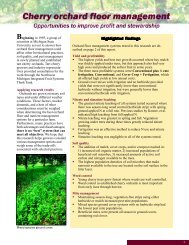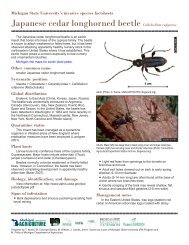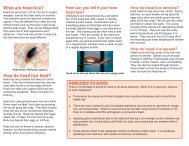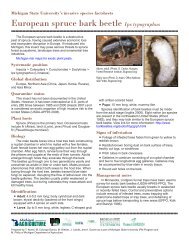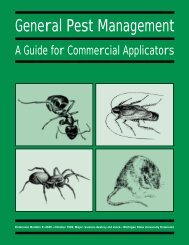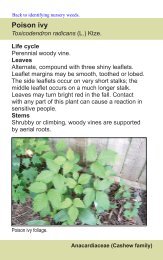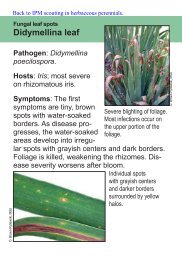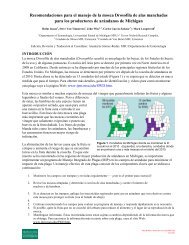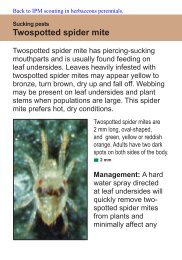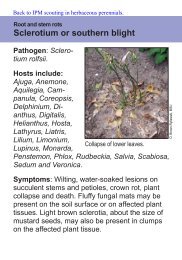Whole Manual - Michigan State University: Integrated Pest ...
Whole Manual - Michigan State University: Integrated Pest ...
Whole Manual - Michigan State University: Integrated Pest ...
You also want an ePaper? Increase the reach of your titles
YUMPU automatically turns print PDFs into web optimized ePapers that Google loves.
Broadcast Sprayer Calibration<br />
There are a number of equally effective calibration<br />
methods that vary in their basic approach and degree of<br />
difficulty. For the purposes of this manual, we have chosen<br />
a simple method that will allow you to calibrate<br />
quickly.<br />
1. Fill the sprayer tank approximately half full with<br />
water.<br />
2. Determine the nozzle spacing or band width in<br />
inches and stake out the appropriate distance in the<br />
field according to the following table:<br />
Broadcast nozzle spacing or<br />
band width (inches)<br />
Travel distance<br />
(feet)<br />
8 510<br />
10 408<br />
12 340<br />
14 291<br />
16 255<br />
18 227<br />
20 204<br />
22 185<br />
24 170<br />
26 157<br />
For other nozzle spacings or band widths, determine<br />
the appropriate travel distance using the following<br />
formula:<br />
4,080<br />
Travel distance (feet) =<br />
nozzle spacing or band width (inches)<br />
In this formula, 4,080 is a constant.<br />
For example, if your nozzle spacing is 38 inches:<br />
4,080 = 107 feet<br />
Travel distance =<br />
38<br />
Measuring the appropriate travel distance is a critical<br />
step in calibration. To determine what volume your<br />
sprayer is delivering per acre, you must relate the average<br />
nozzle output to a smaller unit area of land. You<br />
could determine the volume output by physically spraying<br />
an entire acre, but this would be very time consuming.<br />
Therefore, we use a fraction of an acre.<br />
3. With the sprayer turned off, drive the distance using<br />
the exact throttle setting and gear you plan to use during<br />
spraying. Be sure to note the throttle setting and gear;<br />
don’t rely on a speedometer. Start the spray rig about<br />
25 feet before the staked area so that you will be at typical<br />
field speed at the beginning of the measured distance.<br />
Record your travel time in seconds.<br />
4. Adjust the pressure to the desired setting. Use slightly<br />
higher pressure when you use nozzle check valves and<br />
nozzle strainers.<br />
5. With the sprayer stationary, collect and record the output<br />
(in ounces) from at least four nozzles for the travel<br />
time recorded in step 3. Because we already determined<br />
that the output of all nozzles is within 5 percent of one<br />
another in the precalibration check, it is not necessary to<br />
collect output from all nozzles.<br />
6. Determine the average nozzle output in ounces.<br />
7. The spray rate in gallons per acre is equal to the average<br />
nozzle output in ounces. For example, if the average<br />
nozzle output for the recorded travel time is 20<br />
ounces, the spray rate is 20 gallons per acre.<br />
8. If the spray rate is not reasonable for your particular<br />
spraying job, you can change output by one of three<br />
methods: adjust pressure, change speed, or replace<br />
nozzle tips. If only a minor change in output is needed,<br />
simply make an adjustment in pressure and determine<br />
the new average nozzle output. (Remember that operating<br />
pressure must be kept within the recommended<br />
range for the nozzle type so the spray pattern is not distorted.)<br />
If a large change in output is necessary, make a<br />
change in travel speed. However, you must drive the<br />
designated field distance and determine the new travel<br />
time before calculating the average nozzle output. If<br />
it is impossible to obtain the desired output at an<br />
appropriate pressure and ground speed, you will need<br />
to change nozzle tips; in this case, you must repeat the<br />
precalibration check of nozzle output.<br />
The sprayer is now calibrated. When operated at the<br />
designated speed and pressure, it should deliver the<br />
desired spray volume. You should occasionally remeasure<br />
output to determine if changes in flow rate occurred<br />
as a result of nozzle wear or other variations. If you continue<br />
to use the same travel speed used during initial calibration,<br />
it will take only a few minutes to recheck your<br />
sprayer’s output.<br />
Example: You want to make a postemergence broadcast<br />
application of a herbicide at a spray volume of 20 to<br />
30 gallons per acre using regular flat-fan nozzles spaced<br />
40 inches apart on the boom:<br />
1. Fill the sprayer tank approximately half full with<br />
water.<br />
2. The appropriate travel distance for 40-inch nozzle<br />
spacing is 102 feet; measure and mark this distance in<br />
the field.<br />
3. Using the throttle setting and gear you plan to use during<br />
spraying, you find that it takes 14 seconds to drive<br />
102 feet.<br />
4. Adjust the pressure to the desired setting within the<br />
recommended pressure range of 15 to 30 psi for regular<br />
flat-fan nozzles; your chosen setting is 25 psi.<br />
5. With the sprayer stationary, you collect the following<br />
outputs from four nozzles in 14 seconds:<br />
Nozzle<br />
Output (ounces per 14 seconds)<br />
1 15.5<br />
2 16<br />
3 15.5<br />
4 16<br />
Total = 63 ounces<br />
Vegetable Crop <strong>Pest</strong> Management 27<br />
Chapter 4


